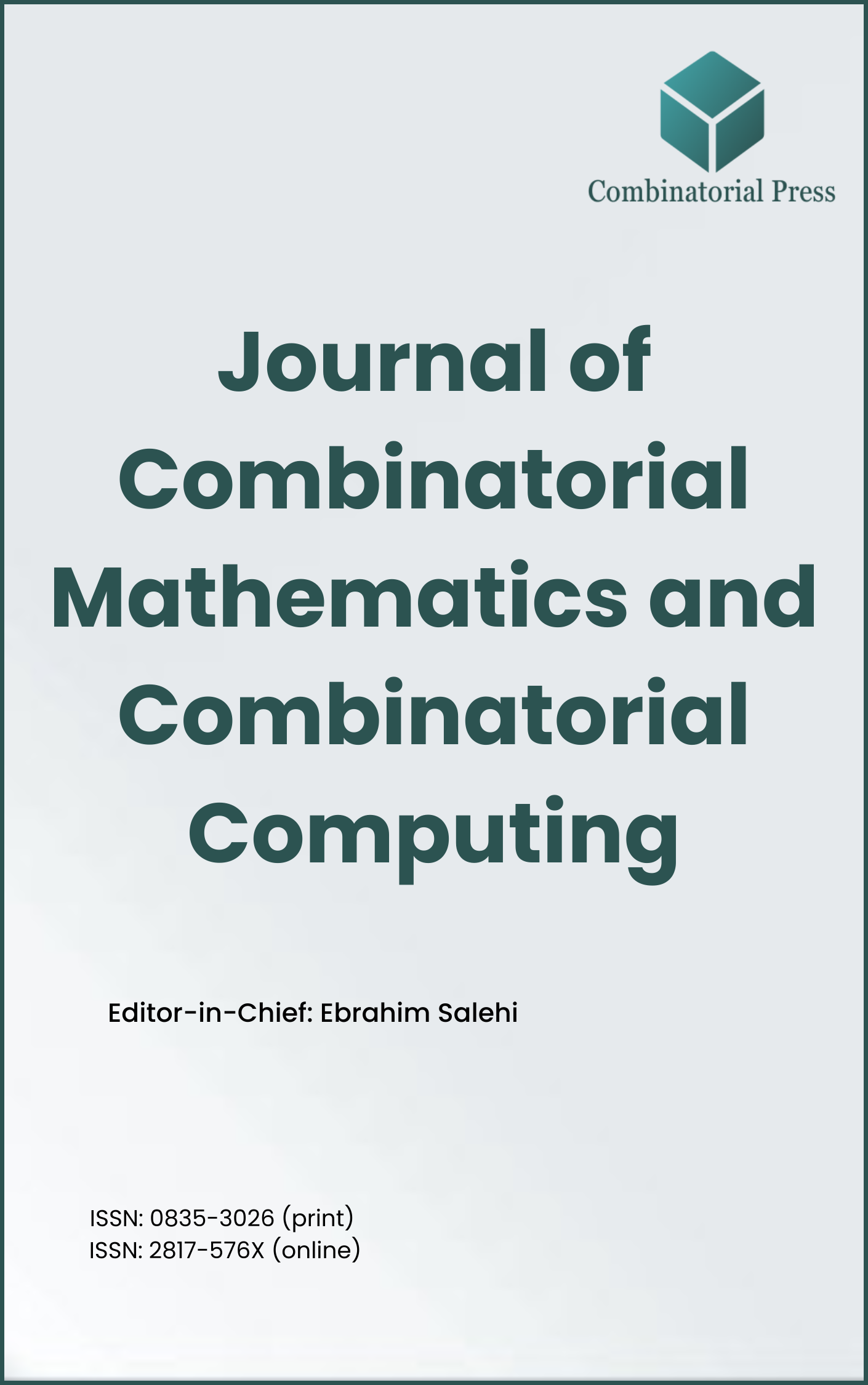
Journal of Combinatorial Mathematics and Combinatorial Computing
ISSN: 0835-3026 (print) 2817-576X (online)
The Journal of Combinatorial Mathematics and Combinatorial Computing (JCMCC) embarked on its publishing journey in April 1987. From 2024 onward, it publishes four volumes per year in March, June, September and December. JCMCC has gained recognition and visibility in the academic community and is indexed in renowned databases such as MathSciNet, Zentralblatt, Engineering Village and Scopus. The scope of the journal includes; Combinatorial Mathematics, Combinatorial Computing, Artificial Intelligence and applications of Artificial Intelligence in various files.
- Research article
- https://doi.org/10.61091/jcmcc124-08
- Full Text
- Journal of Combinatorial Mathematics and Combinatorial Computing
- Volume 124
- Pages: 123-141
- Published Online: 16/03/2025
Let
- Research article
- https://doi.org/10.61091/jcmcc124-07
- Full Text
- Journal of Combinatorial Mathematics and Combinatorial Computing
- Volume 124
- Pages: 99-122
- Published Online: 16/03/2025
In this paper, the hyperoctahedral group algebra
- Research article
- https://doi.org/10.61091/jcmcc124-06
- Full Text
- Journal of Combinatorial Mathematics and Combinatorial Computing
- Volume 124
- Pages: 87-98
- Published Online: 16/03/2025
Let
- Research article
- https://www.doi.org/10.61091/jcmcc124-05
- Full Text
- Journal of Combinatorial Mathematics and Combinatorial Computing
- Volume 124
- Pages: 75-86
- Published Online: 16/03/2025
In today’s era, the rapid development of artificial intelligence is transforming warehousing and logistics by enhancing efficiency and reducing labor costs. In this paper, we first employ a least squares support vector machine to develop an inventory prediction model for warehousing logistics, accurately forecasting inventory values. Next, we design an automated logistics and warehousing architecture that facilitates seamless data transfer and information feedback. Finally, this architecture is used to build a comprehensive inventory management model. Our analysis shows that the AI-based prediction nearly matches the actual inventory value (229 vs. 230) and achieves an inventory turnover rate of 5 times per month, which significantly reduces backlog and improves overall management efficiency and user satisfaction.
- Research article
- https://doi.org/10.61091/jcmcc124-04
- Full Text
- Journal of Combinatorial Mathematics and Combinatorial Computing
- Volume 124
- Pages: 59-74
- Published Online: 16/03/2025
The Cascaded Integrator Comb (CIC) decimation filter is a pivotal technology extensively employed in digital signal processing (DSP). This paper delves into a comprehensive examination of the CIC algorithm within software-defined radio (SDR) systems from the perspective of parallel computing and introduces a novel Non-Recursive Implementation (NR-I) on an NVIDIA GPU using CUDA. The NR-I approach significantly reduces computational load by unfolding the recursive CIC structure with pre-derived Unfold Factors. Further optimization was achieved through data-transfer enhancements using PM Implementation (PM-I) and ODT Implementation (ODT-I). Experimental results demonstrate that NR-I achieves a speedup of over 449.48. Additionally, the data-transfer optimizations resulted in substantial performance improvements, with PM-I and ODT-I reducing execution time by 43.24% and 64.22%, respectively. The GPU implementation’s speedup is significantly greater than that of OpenMP, ranging from 3.34 to 10.22 times. These results underscore the effectiveness of the proposed Non-Recursive Implementation in accelerating time-intensive and data-intensive computations.
- Research article
- https://doi.org/10.61091/jcmcc124-03
- Full Text
- Journal of Combinatorial Mathematics and Combinatorial Computing
- Volume 124
- Pages: 47-58
- Published Online: 16/03/2025
This paper presents a new sequence called the
- Research article
- https://doi.org/10.61091/jcmcc124-02
- Full Text
- Journal of Combinatorial Mathematics and Combinatorial Computing
- Volume 124
- Pages: 23-45
- Published Online: 16/03/2025
In the era of globalization and intense market competition, strategic human resource management (SHRM) is critical for boosting corporate competitiveness. This study employs structural equation modeling (SEM) and multiple linear regression to uncover the complex influence of SHRM perceptions on employee proactive behaviors, and uses a convolutional neural network (CNN) to explore nonlinear relationships and validate the SEM findings. Results reveal that SHRM perception has a significant positive effect on employee proactive behavior (
- Research article
- https://doi.org/10.61091/jcmcc124-01
- Full Text
- Journal of Combinatorial Mathematics and Combinatorial Computing
- Volume 124
- Pages: 3-21
- Published Online: 16/03/2025
One of the urgent challenges in auditing today is preventing accounting management risk. This study integrates big data auditing technology to enhance audit quality by developing an audit risk assessment index system based on material misstatement risk and inspection risk. By combining the hierarchical analysis and entropy weighting methods to assign risk indicators, the accounting audit risk index for Company Z was calculated using a multi-level fuzzy comprehensive evaluation method and regression analysis to examine impact factors. Empirical evidence shows that the overall expected audit risk is 0.412—indicating a low to average risk level—with significant correlations between the previous year’s audit opinion, audit fee, and other factors such as the largest shareholder’s holding, board size, percentage of independent directors, operating income growth, net profit, and the audit environment. The study focuses on developing effective prevention and response strategies in the era of big data and offers recommendations to reduce potential auditing risks.
- Research article
- https://doi.org/10.61091/jcmcc123-42
- Full Text
- Journal of Combinatorial Mathematics and Combinatorial Computing
- Volume 123
- Pages: 585-626
- Published: 31/12/2024
Let
- Research article
- https://doi.org/10.61091/jcmcc123-41
- Full Text
- Journal of Combinatorial Mathematics and Combinatorial Computing
- Volume 123
- Pages: 577-584
- Published: 31/12/2024
An undirected graph is said to be cordial if there is a friendly (0,1)-labeling of the vertices that induces a friendly (0,1)-labeling of the edges. An undirected graph





